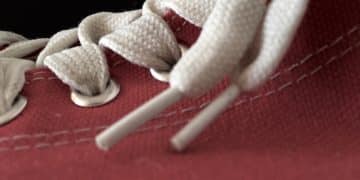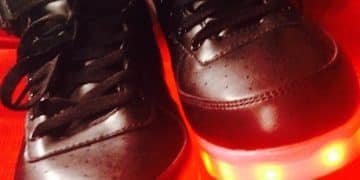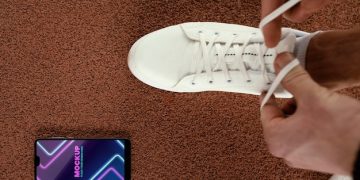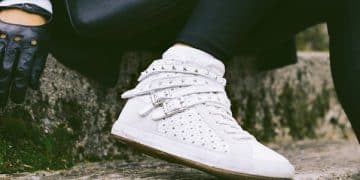Spot Fake Sneakers 2025: 7-Point Authentication Guide
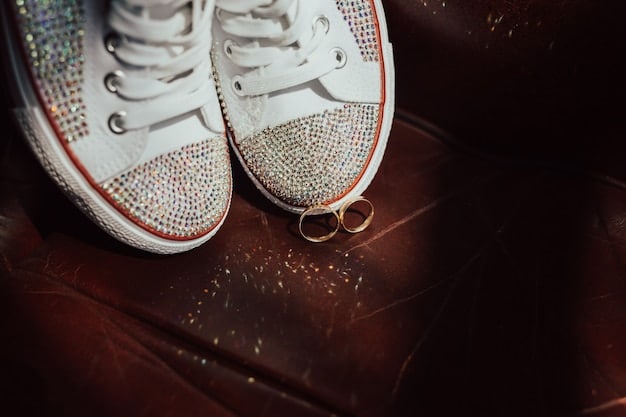
Navigating the complex world of limited-edition sneakers in 2025 requires vigilance, as counterfeiters employ increasingly sophisticated tactics, making effective authentication crucial to protect investments and ensure originality.
The allure of limited-edition sneakers is undeniable, driving a multi-billion dollar secondary market fueled by passion and prestige. However, this lucrative landscape also attracts an ever-evolving wave of counterfeiters, making the ability to verify authenticity more critical than ever. In 2025, distinguishing a genuine grail from a convincing fake demands an expert eye and a systematic approach. This guide provides a definitive How to Spot Fake Limited-Edition Sneakers in 2025: A 7-Point Authentication Checklist, equipping you with the knowledge to safeguard your collection and your wallet.
The Evolving Threat: Why Counterfeits are Harder to Spot in 2025
The art of sneaker counterfeiting has undergone a significant transformation. Gone are the days of obviously shoddy replicas; today’s top-tier fakes, often referred to as “reps,” are produced with alarming precision, mimicking everything from the stitching patterns to the scent of authentic materials. This sophistication is driven by technological advancements, improved access to replica materials, and a global supply chain that enables rapid reproduction and distribution.
The scale of the problem in 2025 is vast. Counterfeiters leverage detailed 3D scans of genuine products, reverse-engineer proprietary manufacturing processes, and even source similar material compositions. This makes the traditional “eye test” insufficient for the casual enthusiast. Without a structured, comprehensive approach, even seasoned collectors can fall prey to increasingly convincing fakes, leading to financial losses and a tarnished reputation within the sneaker community.
Advancements in Counterfeit Technology
Today’s counterfeiters aren’t just copying; they’re innovating. They invest in advanced machinery, sometimes even acquiring discarded or outdated equipment from legitimate factories. This allows for higher quality control and more accurate reproductions of intricate details that were once clear tells. The internet also provides an invaluable resource, allowing them to study detailed unboxing videos and authentication guides, directly addressing weaknesses in their previous iterations.
- 3D Scanning & Printing: Used to meticulously replicate sneaker molds and intricate design elements.
- Improved Material Sourcing: Access to a wider range of materials that closely resemble authentic leathers, suedes, and knits.
- Enhanced Manufacturing Processes: Employing techniques that mimic factory-level production, reducing inconsistencies.
- Feedback Loops: Counterfeiters actively monitor authentication forums and videos to refine their products.
The Impact on the Sneaker Market
The prevalence of high-quality fakes creates a climate of distrust in the secondary market. Buyers become more hesitant, prices for genuine articles can become depressed, and the overall integrity of the hobby is threatened. Beyond the individual financial loss, there’s a broader ethical concern regarding supporting illegal operations that often exploit labor and ignore environmental regulations. Therefore, understanding the nuances of authentication is not just about protecting your purchase; it’s about preserving the culture itself.
The sneaker resale market, projected to reach over $30 billion by the end of the decade, relies heavily on trust. Counterfeits erode that trust, making every transaction a potential risk. This article aims to empower buyers with the tools to navigate this challenging environment, ensuring that their passion remains for genuine artistry and craftsmanship.
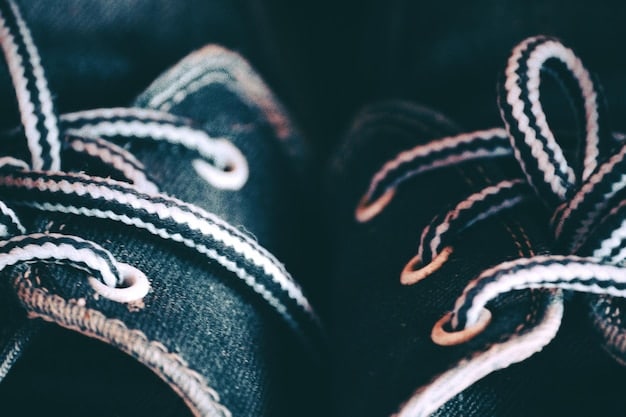
Point 1: The Box and Packaging – First Impressions Matter
Often overlooked in the excitement of a new pair, the shoebox and its internal packaging can reveal a wealth of information about a sneaker’s authenticity. Genuine manufacturers invest significantly in their branding, materials, and presentation, something counterfeiters frequently struggle to replicate perfectly. In 2025, these seemingly minor details remain crucial components of a robust authentication process.
Begin by examining the box itself. Genuine Nike, Adidas, or other high-end brand boxes will typically be sturdy, with crisp graphics and accurate color reproduction. Fakes often feature flimsy cardboard, blurry logos, or colors that are slightly off. Pay close attention to the print quality of the labels inside and outside the box; misspellings, incorrect fonts, or misplaced barcodes are immediate red flags. Every detail, from the exact placement of a logo to the texture of the tissue paper, contributes to the overall impression of authenticity.
Label Accuracy and QR Codes
The sizing label on the box is a critical point of inspection. Ensure all information matches the shoe inside—style code, color code, size, and country of manufacture. In 2025, many brands also incorporate QR codes on their boxes. These should lead to the official product page or a verified authentication service. Counterfeit QR codes might lead nowhere, to a generic page, or even to a malicious site. Always scan these with caution and cross-reference the URL.
- Font and Print Quality: Authentic labels have clear, consistent fonts and sharp printing. Fakes often show pixelation or inconsistencies.
- Barcode Matching: Verify the barcode on the box with the shoe’s internal tags. Many apps can scan and confirm details.
- Country of Manufacture: Double-check that the listed country of manufacture aligns with known production sites for that particular model and release.
Internal Packaging and Accessories
Genuine limited-edition sneakers often come with specific accessories: extra laces, hangtags, special tissue paper, or even authenticity cards. These are not just add-ons; they are part of the brand’s premium experience. Fakes may include incorrect accessories, cheap imitations, or omit them entirely. The quality of the tissue paper is also a tell: authentic paper feels substantial and often features subtle branding, while fakes use thin, generic tissue.
Even the way the shoes are packed within the box can offer clues. Brands have specific methods for wrapping and positioning their sneakers. Deviations from these norms, such as shoes haphazardly thrown in the box, can indicate a counterfeit. This meticulous attention to packaging highlights the brand’s commitment to quality from the moment of unboxing.
Point 2: Material Quality and Texture – A Tactile Examination
One of the most revealing aspects of a fake sneaker, even in 2025, remains the quality of its materials. While counterfeiters have improved significantly, replicating the exact feel, elasticity, and durability of premium leathers, suedes, knits, and synthetic overlays is a monumental challenge. Genuine brands invest heavily in research and development to source and create materials that meet their exacting standards, something replica factories rarely achieve.
Start by touching the shoe. Does the leather feel supple and rich, or stiff and plastic-like? Does suede feel soft and luxurious, or rough and coarse? Knitted uppers should feel dense and uniform, not thin or loosely woven. Even certain synthetic materials have a distinct texture and flexibility that fakes often miss. This tactile inspection is not just about superficial appearance; it’s about the inherent properties of the materials themselves.
Common Material Discrepancies
Specific materials often present unique challenges for counterfeiters. For instance, authentic Boost technology (Adidas) has a distinct squishy yet resilient feel, with a visible texture. Fakes often use a cheaper foam that may look similar but feels rigid and lacks the characteristic bounce. Similarly, Nike’s Flyknit or Primeknit uppers have a specific weave pattern, density, and flexibility that are difficult to perfectly mimic without proprietary machinery and materials.
- Leather: Genuine leather has a natural grain, can show minor imperfections, and often has a distinct aroma. Fakes often use PU leather, which feels uniform, smooth, and may have a chemical smell.
- Suede/Nubuck: High-quality suede naps smoothly and changes color when brushed. Fakes can feel stiff, coarse, or fail to show color variation.
- Knits (Flyknit, Primeknit): Authentic knits are dense, stretchy, and have a consistent pattern. Fakes may be looser, less flexible, or show irregular weaving.
The Smell Test (Yes, Really!)
While not a scientific method, the scent of a sneaker can provide an anecdotal clue. Authentic sneakers, especially those crafted from genuine leather, often have a subtle, natural aroma. Counterfeit shoes, conversely, frequently emit a strong chemical or glue-like odor. This is due to the use of cheaper materials and adhesives that haven’t been properly cured or are simply of lower quality. While not a definitive authentication point, a strong, unpleasant chemical smell should certainly raise a red flag and prompt further investigation.
The combination of visual and tactile cues regarding material quality is a powerful tool in your authentication arsenal. Genuine materials not only look and feel better but also contribute significantly to the sneaker’s comfort, durability, and overall wear experience. Any compromise here is a strong indicator of a counterfeit, regardless of how well other details might be copied.
Point 3: Stitching and Construction – The Devil in the Details
The meticulousness of stitching and overall construction is a hallmark of authentic, high-quality sneakers. While counterfeiters have improved their general assembly, the precision required for perfect stitching, flawless seams, and consistent panel alignment often remains a stumbling block. In 2025, these small, often overlooked details are still powerful indicators of a shoe’s legitimacy.
Examine the stitching throughout the shoe. It should be uniform, tight, and evenly spaced, with no loose threads or frayed edges. Authentic shoes feature consistent stitch length and density across all panels. Pay close attention to areas where different materials meet, like the transition between the toe box and side panels. These junctions should be clean and precise, without excess glue or uneven cuts.
Key Areas for Stitch Inspection
Certain parts of a sneaker are particularly prone to revealing flaws in counterfeit construction. The stitching around the Swoosh (Nike), the Adidas Three Stripes, or any other intricate branding elements should be perfect. These logos are often critical to the brand identity, and manufacturers ensure their execution is flawless. Also, check the stitching on the tongue, inside lining, and around the eyelets for laces.
- Logo Stitching: Ensure all brand logos are cleanly stitched with consistent thread color and density.
- Seam Alignment: All seams should meet precisely, without gaps, overlaps, or crooked lines.
- Even Spacing: Stitches should be evenly spaced with uniform length throughout the shoe.
Midsole and Outsole Construction
Beyond the upper, the construction of the midsole and outsole provides further clues. The bond between the upper and the midsole should be clean, with minimal or no visible glue residue. Authentic midsoles are often molded with precision, displaying smooth contours and consistent textures. Fake midsoles might look rougher, have inconsistent paint application, or show mold lines that aren’t present on real pairs.
The outsole patterns and grooves should also be sharp and well-defined. Manufacturers often use proprietary rubber compounds for durability and traction, leading to a specific feel. Counterfeits might use cheaper, harder, or softer rubber that wears down quickly and feels different to the touch. Look for the exact shape and depth of the tread patterns, comparing them to known authentic examples. Any deviation, however subtle, can be a sign of a fake.
Point 4: Branding and Logos – The Signature of Authenticity
Every brand carefully crafts its logos, typography, and unique branding elements, treating them as signature identifiers. Counterfeiters, despite their advancements, frequently make mistakes in replicating these crucial details. In 2025, paying close attention to the nuances of brand placement, font consistency, and logo execution remains a cornerstone of effective sneaker authentication.
Examine every instance of branding on the shoe: the heel tab, tongue label, insole, outsole, and any embossed or printed logos. Are the fonts correct? Is the spacing between letters accurate? Is the logo precisely positioned according to authentic product images? Even subtle variations in font weight, letter shape, or logo size can be immediate giveaways.
The Devil in the Details: Specific Logo Inspections
For Nike, the angle and curve of the Swoosh are frequently missed by fakes. It should have a distinct shape and proportion that is hard to replicate perfectly. Similarly, the “AIR” text on many models needs to be precise in font, size, and placement. Adidas’s Three Stripes and Trefoil logo also have very specific characteristics. The points and curves should be sharp and clean, not rounded or blurry.
- Font Consistency: Compare all text on the shoe (labels, embroidery, prints) to official brand fonts.
- Logo Placement: Verify that logos are in the correct position and angle, not too high, too low, or off-center.
- Quality of Embossing/Printing: Embossed logos should be sharp and deep, while printed logos should be crisp and not easily rubbed off.
Insoles and Internal Branding
Don’t forget to remove the insoles. Often, the quality of the insole print and the material of the insole itself can be a major tell. Authentic insoles usually have a high-quality print that resists peeling or fading, along with specific branding. Fakes might have sloppy prints, use incorrect fonts, or feature cheaper, less comfortable foam. The stitching underneath the insole is also worth inspecting; official pairs often have neat, consistent stitching, whereas fakes might show irregular or messy work.
The internal size tag, usually stitched inside the tongue or collar, is another critical element. Verify the style code, production date, and factory code against known authentic examples. Many online databases and authentication apps can help cross-reference these codes. While counterfeiters can copy these tags, inconsistencies with the shoe’s overall quality or with known authentic details can still expose a fake.
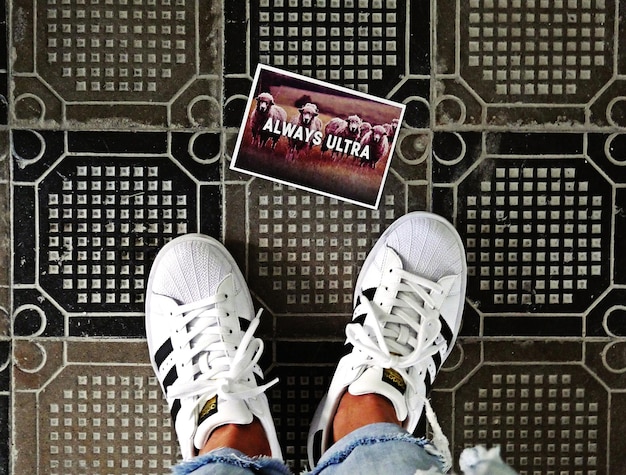
Point 5: Unique Features and Release Specifics – Beyond the Generic
Limited-edition sneakers are often distinguished by unique features that set them apart from general release models. These can include specialized materials, glow-in-the-dark elements, reflective accents, unique lacing systems, or bespoke colorways. Counterfeiters generally struggle to replicate these intricate and often proprietary elements with perfect accuracy, making them valuable points of authentication in 2025.
Research the specific shoe model you’re authenticating. What unique characteristics were highlighted in its official release? For example, if a shoe was heralded for its specific reflective material, test it with a flashlight. If a sneaker features special glow-in-the-dark soles, expose them to light and then darkness. The presence and quality of these features are often strong indicators of authenticity.
Color Matching and Pigmentation
Color accuracy is paramount, especially for limited editions that often boast exclusive color palettes. Counterfeiters sometimes struggle to achieve identical shades of dyes and paints. Compare the shoe’s colors to high-resolution official images. Are the hues vibrant and true, or do they appear duller, lighter, or slightly off by comparison? This is particularly relevant for intricate patterns or gradient designs, where even a slight variation can expose a fake.
- Reflective Materials: Test reflectivity in low light with a flash. Fakes often use lower quality, less reflective materials.
- Glow-in-the-Dark Elements: Charge with light and observe glow intensity and duration.
- Special Textures/Patterns: Ensure embossed patterns, lenticular effects, or unique textures are accurately replicated.
Weight and Ergonomics
The overall weight and feel of the sneaker in hand can also provide clues. Authentic sneakers are engineered with specific materials and technologies that contribute to a certain weight and balance. Fakes, using cheaper, often different materials, might feel noticeably lighter or heavier, or simply have an unbalanced feel. Try on the shoes, if possible. Do they feel comfortable and supportive as expected for the model, or do they feel stiff, cheaply made, or ill-fitting?
Furthermore, consider the shoe’s ergonomics. Authentic sneakers are designed for performance and comfort, with precise arch support, cushioning, and fit. Fakes often lack this ergonomic engineering, leading to a flat, uncomfortable feel, or an awkward fit. This is particularly true for high-performance models where intricate design plays a functional role. Any discomfort or unusual feel during a brief wear can be a subtle but important red flag, indicating a departure from the original design’s intent.
Point 6: Seller Reputation and Purchase Platform – The Context of Your Buy
While the physical examination of the sneaker is paramount, the context of your purchase—the seller and the platform—is an equally critical factor in authentication, especially in 2025. Even the most expert eye can be fooled by an exceptionally good fake. Therefore, mitigating risk by choosing reputable sellers and secure platforms is an essential first line of defense against counterfeits.
Always prioritize purchasing from official retailers, brand boutiques, or highly reputable secondary market platforms with robust authentication services. If buying from a private seller, their reputation should be impeccable. Look for extensive positive feedback, a history of selling collectible items, and a willingness to provide detailed photos and answer questions transparently. A lack of transparency or an insistence on meeting in obscure locations should always raise suspicion.
Utilizing Trusted Resale Platforms
Platforms like StockX, GOAT, and eBay’s Authenticity Guarantee have invested heavily in intricate authentication processes, employing teams of experts to inspect every shoe before it reaches the buyer. While no system is absolutely flawless, these services significantly reduce the risk of receiving a fake. Understand their authentication policies and buyer protection guarantees, as these can be invaluable if a problem arises.
- Seller Feedback: Check buyer reviews and seller ratings on platforms.
- Return Policies: Understand the platform’s return policy for items found to be inauthentic.
- Authentication Services: Opt for platforms that physically authenticate shoes before shipment.
Price as a Red Flag
The old adage “if it’s too good to be true, it probably is” holds significant weight in the limited-edition sneaker market. If a price is significantly below market value, especially for a highly sought-after grail, it’s a major red flag. Counterfeiters often lure buyers with unbelievably low prices. While discounts can occur, an offer that deviates drastically from established resale values should trigger extreme caution.
Be wary of sellers who refuse to provide additional photos beyond a few blurry shots, or who pressure you into quick transactions outside of official platforms. Legitimate sellers understand the importance of transparency and are usually happy to provide as much detail as needed to assure a buyer. Remember, a responsible buyer considers not just the shoe itself, but also the entire transaction environment, to minimize the risk of a fraudulent purchase.
Point 7: Expert Verification and Community Resources – Leverage Collective Knowledge
Even with the most thorough personal inspection, some high-grade counterfeits can be incredibly difficult to discern. In 2025, leveraging expert verification services and tapping into the vast knowledge of the global sneaker community provides an invaluable final layer of authentication. No single individual knows everything, but collective intelligence and specialized tools can provide the definitive answer you need.
Many online and in-person authentication services exist, often staffed by experts with years of experience and access to databases of authentic and fake examples. These services use specialized tools, high-resolution imaging, and deep product knowledge to cross-reference details that the average person might overlook. They can spot minute differences in stitching, material composition, and even microscopic branding elements.
Online Authentication Apps and Groups
Several apps and online communities are dedicated to sneaker authentication. Apps like Legit Check By Ch, CheckCheck, or even dedicated subreddits on Reddit (e.g., r/Repsneakers for identifying fakes) allow users to upload photos for community review. While community advice should be taken with a grain of salt, highly active and knowledgeable members can often provide quick insights and point out obvious flaws.
- Dedicated Authentication Apps: Utilize services designed specifically for sneaker verification.
- Online Forums & Communities: Share photos and seek opinions from experienced collectors.
- Reputable Resale Platforms: Use the authentication services offered by major platforms.
The Importance of Reference Materials
Always compare the sneaker in question to multiple high-resolution images of authentic pairs from various reputable sources. Don’t rely on just one picture or one review. Cross-reference official product shots, detailed unboxing videos, and professional photography from legitimate retailers. Pay attention to every angle, every stitch, and every material detail. Subtle differences accumulate to tell the full story.
Finally, stay informed. The methods of counterfeiters are constantly evolving, and so must your authentication skills. Follow sneaker news outlets, join online communities, and keep up with new authentication guides and techniques. The more knowledgeable you are about specific models and general counterfeiting trends, the better equipped you’ll be to make an informed decision. Combining your detailed personal inspection with expert and community resources offers the most comprehensive defense against fakes in today’s complex sneaker market.
| Key Authentication Point | Brief Description |
|---|---|
| 📦 Box & Packaging | Examine label accuracy, print quality, and QR codes for inconsistencies. |
| 🧵 Stitching & Build | Look for uniform, tight stitches, clean seams, and accurate panel alignment. |
| ✨ Unique Features | Verify reflective elements, glow-in-the-dark properties, and exclusive material textures. |
| 🤝 Seller Reputation | Buy from trusted platforms or sellers with excellent feedback histories to minimize risk. |
Frequently Asked Questions About Sneaker Authentication
Yes, factory flaws can occur on authentic pairs, but they are typically minor imperfections like slight glue stains or a single loose thread, not systemic issues. Counterfeits, however, often exhibit multiple, more significant construction errors across various pairs, indicating a lack of consistent quality control beyond typical manufacturing variances.
Generally, no. Official brands rarely include elaborate “authenticity cards” as a primary method of verification. While some high-end luxury items might, for sneakers these cards are often produced by counterfeiters to lend a false sense of legitimacy. Always rely on the sneaker’s inherent features and brand-specific details for authentication, not generic cards.
UV light can be a useful supplementary tool. Some authentic sneakers have hidden UV markings or react in specific ways under UV light, while fakes might show unintended glue lines or materials that glow unnaturally. However, UV tests are not definitive alone, as counterfeiters are adapting to this method, and not all authentic shoes have distinct UV features.
The most effective strategy is to engage with reputable sneaker communities online (forums, subreddits, dedicated authentication groups) and follow expert authenticators on social media. These platforms often share real-time updates on emerging fake versions and new tells. Continuous learning and vigilance are key to staying ahead in the fight against counterfeits.
While stories of “factory variants” or “leftovers” from authentic production lines circulate, they are extremely rare and highly suspect for limited-edition releases. Most shoes sold outside official channels are unauthorized productions, meaning they are still counterfeits. For true authenticity, purchasing through official retailers or verified resale platforms is always recommended, as it protects against illegal production.
Conclusion: The Art of Vigilant Authentication
As the sneaker market continues its rapid evolution into 2025, the challenge of authenticating limited-edition pairs becomes increasingly intricate. Counterfeiters, armed with sophisticated technology and an ever-improving understanding of genuine manufacturing, produce replicas that can deceive even the careful observer. However, by diligently applying this 7-point checklist—meticulously examining the box, materials, construction, branding, unique features, and the context of the purchase, while also leveraging expert resources—collectors can significantly bolster their defenses.
The journey of authentication is not merely about finding flaws; it’s about appreciating the genuine artistry and quality that define authentic limited-edition sneakers. Armed with knowledge and a methodical approach, buyers can navigate the secondary market with confidence, protecting their investments and ensuring that their passion remains for truly original and legitimate pieces of sneaker history.
